This article appeared in the Fall 2017 issue of The Ojai Quarterly, and is posted here with permission. “The Art of Dennis Shives” exhibit is on view at the Ojai Valley Museum from Oct. 14, 2017 through February 25, 2018.
Dennis Shives His Way
by
Mark Lewis
For the better part of seven decades, self-taught Ojai artist Dennis Shives has followed his own path, often while going barefoot. Now, that long and winding road has led this notable free spirit to the Ojai Valley Museum, which this fall is honoring him with a career-retrospective exhibit. After forging a career on his own terms, far from the art-world limelight, Shives finally is ready for his close-up.
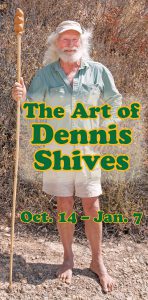
THE BUILDING was nondescript, an unassuming stucco affair fronting on El Roblar Drive west of Padre Juan Street in Meiners Oaks. But its display window was lit up at night, and something in it caught the eye of the artist Gayel Childress as she passed by one evening in the early 1980s.
“There was this wonderful wooden Gatling gun in the window,” she says. “I said I had to meet whoever made that.”
The creator turned out to be Dennis Shives, an artist and woodworker who used the building as his studio and the window as his gallery. Childress discovered to her delight that Shives’s hand-cranked Gatling gun actually worked, except that it fired rubber bands rather than bullets. He had crafted it a few years earlier using wood left over from another project – oak, ash, a bit of walnut – and part of a bronze light fixture he had salvaged from the Smith-Hobson House while it was being converted into Ojai’s City Hall. Childress was charmed by this whimsical, one-of-a-kind creation, and by the man who made it.
“I’ve been a fan ever since,” she says. “He really is a wonderful artist.”
That’s high praise coming from Childress, a co-founder of the Ojai Studio Artists group. Nor is she the only one who thinks so.
“A really incredible talent,” says Khaled Al-Awar, who in years past has featured the Gatling gun and other Shives pieces in his Primavera Gallery in the Arcade.
“He’s brilliant,” agrees Danna Tartaglia, who sells Shives prints, and framed photographs of his “Making Faces” rock art, in her Tartaglia Fine Arts gallery. “He’s an original – maybe the original Ojai artist.”
But Tartaglia and Al-Awar agree that Shives is not the easiest artist to represent, because of his unconventional attitude toward his career. He insists on asking dauntingly major-league prices for his major pieces, in part because of all the work he puts into making them, and in part because he seems too attached to his creations to let them go.
Partly as a result, Shives has struggled all his life to make a decent living, and to win wide recognition in the art world. Nevertheless, he has remained true to his chosen vocation. And now, on the eve of his 70th birthday, the spotlight finally has found him, in the form of a career-retrospective exhibit opening Oct. 14 at the Ojai Valley Museum. Which prompts the question: After a lifetime of wandering in the wilderness, is Dennis Shives ready for the red carpet?
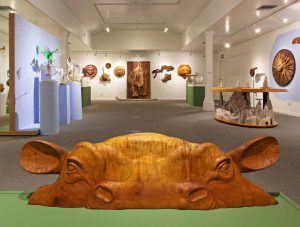
BORN in Santa Paula in 1947, Shives mostly grew up in Ojai’s Upper Valley, where he attended the Summit School. Later he attended Matilija Junior High and Santa Paula High, from which he graduated in 1965. As a child he was drawn to art, due in part to encouragement from his maternal grandmother, a talented amateur painter.
“I always knew I would be an artist,” he says.
But he hated the art classes he took in high school and at Ventura College. There were too many rules about how to make art, and too much emphasis on how to make a living from it.
“I really didn’t learn anything in school,” he says. “So actually I’m self taught.”
The point of art classes, as Dennis saw it, was to tame the wildly creative urges that welled up within him, and channel them in approved directions. He declined to submit. He was a classic case of the child who refuses to color inside the lines.
“They are trying as hard as they can to kill that thing within you,” he says. “You’re supposed to be who you are. People need to do what they need to do, instead of sitting and copying other people.”
Despite his interest in the visual arts, the first career he pursued that of a musician. A true child of the ‘60s, Shives grew his hair long and tried his hand at rock ‘n’ roll, playing harmonica and singing with the Ojai All Stars, the house band at a rowdy, rough-and-tumble dive called the Ojai Club (located where Ojai Pizza is today). This was a fraught period when the local flower children and the local rednecks were frequently at odds.
“We were the hippies and they were the alcoholics,” Shives says. “This was a drunk cowboy town. There was a brawl every Saturday night.”
The All Stars’ lineup also included local guitar legend John Orvis, along with the brothers Norman and Curtis Lowe and others.
“We had a great time,” Shives says. “But then I switched into the arts.”
He took up woodworking, sculpture, painting, and whatever else intrigued him. He was a craftsman too, creating gold and silver jewelry, custom-carved rifles, exoticlooking furniture, even a house in Alaska for his Ojai friend Jack Estil. He never worried about not being formally trained. He just plunged in, and figured it out for himself.
“What the process is all about is learning not to be afraid,” he says. “Fear is the biggest killer of creativity.”
His longtime friend Sergio Aragones, the famous Mad Magazine artist, admires Shives’s extraordinary versatility.
“He’s the true Renaissance man,” Aragones says. “He’s a man who can do everything – and well! He has spent his life perfecting every craft.”
And to what end? To amuse himself, and other people, by telling stories that make everyone smile. There is an implied narrative embedded in most Shives pieces, whether it’s a painting of snails in a garden eating a flower, or a carved-wood door featuring a charging rhinoceros, or a soapstone sculpture of an octopus going for a walk.
“It was the storytelling process that I was interested in,” he says. “You’re playing with the story. It’s a way of entertaining people.”
When Shives turned his hand to creating parade floats, he entertained the entire town. People in Ojai still talk about the one he and his friend Rick DeRamus came up with in 1984, the year the Los Angeles Summer Olympics held rowing events at Lake Casitas. Shives’s float for that year’s Fourth of July parade was inspired by the legend of Old Hoover, the monster-sized largemouth bass said to lurk in the Casitas depths, too wily for any angler to hook.
“All the local kids dressed up as minnows and frogs,” he says, “and we chased ‘em down the street with the fish.”
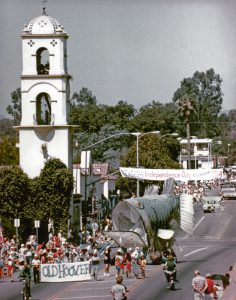
For the 1986 parade, Shives and DeRamus constructed an even more elaborate version of Old Hoover. This second mechanized fish float was 40 feet long, 10 feet wide and 14 feet high, with a tail that wagged, gills that emitted air bubbles, and a huge mouth that swung open and shut as the bass pursued a man in a frog costume riding a bicycle along Ojai Avenue.
This was classic Shives: He put in seven months, uncompensated, to create Old Hoover II, then spent his last $5 on gas so he could drive it in the parade. People loved the float, of course, but they didn’t pay anything to see it.
“I never did anything that made me money,” he says. “I just barely scraped by.”
That period in the early ‘80s when he had the building on West El Roblar Drive was an anomaly. Generally, Shives has made his art in borrowed spaces, or at home. These days his studio is the house on Willow Street he shares with his life partner, the acupuncture provider Laurie Edgcomb. Here, Shives is surrounded by his sculptures, paintings, carved masks, bubble-blowing devices and fanciful furniture pieces. Many have attracted the attention of collectors, but Shives seems reluctant to part with them.
“Making art is completely different from making money,” he says. “I’m not doing this to sell stuff. I’m doing this because it makes me want to get up in the morning.”
On the other hand, he concedes, “You need to make a living.”
Indeed, and making a living as a working artist poses enormous challenges. Those who succeed usually find that they must put as much time and energy into marketing their art as they do into creating it.
“I guess you have to go out and seek it and chase it down,” Shives says, with a noticeable lack of enthusiasm. He’d much rather drive his ancient Volkswagen van out to the East End, take off his shoes, and go for a walk in Horn Canyon.
Shives is not averse to making a buck or two, if he can do it his way. He sells hand-carved wooden walking sticks, baby spoons and magic wands (a Shives specialty). He also sells copies of his charming 2014 book, “True Stories To Be Read Aloud,” a collection of autobiographical stories. (A follow-up collection is due out this fall.) And, while he seems reluctant to sell his paintings, he happily sells prints of them at Danna Tartaglia’s gallery. She says they are popular choices with visitors looking for something Ojai-esque to take home with them – such as “Smudgepot Bears,” featuring merry ursine revelers cavorting in an orchard on a cold winter’s night, with Chief Peak providing the backdrop.
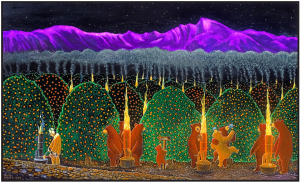
“I’m not sure what success is,” Shives says. “I do what I do, and feel pretty successful in my own little realm.”
Case in point: Shives is spectacularly successful at sand sculpture. He has a shelf full of first-place trophies won at contests held at Cayucos Beach and elsewhere. This probably is the art form for which he is best known outside of Ojai, but these are things he cannot sell – and that’s partly what attracted him to sand sculpting in the first place. He creates a large-scale piece in a few hours, takes a photograph, and walks away.
“If these things last the afternoon, they’re lucky,” he says. “Nothing lasts forever.
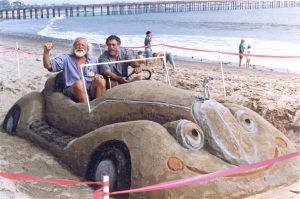
SHIVES is a familiar sight in Ojai: tall and tanned with long white hair, a flowing beard and a gentle smile, he favors khaki work shirts and cargo shorts, and gives the impression that he has never owned a pair of socks. If you want to walk a mile in his moccasins, you’ll have to do it barefoot, for when Shives hits the trail in the Los Padres National Forest he does it sans shoes.
“For two years, I took every Wednesday off and walked with him,” Khaled Al-Awar says. “This man has an incredible knowledge about nature.”
Roger Conrad of the Ojai Valley Museum says that Shives’s art is powerfully informed by his strongly felt connection with the natural world.
“His vision is derived from nature with childlike enthusiasm to see, touch, and create vivid experiences for himself and those that interact with his art,” Conrad says. “Whimsy is his language to find the spiritual in all living things. His message is that the lives of all creatures matter.”
“Whimsical” is a word often applied to Shives, and it’s not one that connotes serious artistic purpose in today’s high-powered art world. Untutored artists like Shives who lack academic credentials often are pigeonholed as outsider artists or folk artists. But Gayel Childress says Shives falls into none of these categories.
“I love outsider art, but his is quite sophisticated,” she says. “He has that outsider spirit, but his art is certainly not naïve. I don’t think there’s a term for Dennis. He’s one of a kind – part inventor, part engineer, part dreamer, part carpenter, part painter. Little touches of everything.”
Conrad, who is helping to organize the museum’s upcoming Shives exhibit, is similarly unwilling to hang a label on this unique artist.
“His art defies categorization,” Conrad says. “Some of his work seems primitive but other works display the hand of a seasoned artist. He pleases himself and dismisses being labeled. Above all else his art is enchanting and fun.”
The museum exhibit is a big deal for Shives, and his friends and supporters are thrilled for him.
“It’s his time,” Childress says. “I really want everyone to see this show. I want everybody in Ojai to know about him. I just want to see him honored because he surely deserves it.”
“It’s about time,” Aragones says. “He deserves it because of the variety of his art.”
To be clear, Shives had not exactly spent the past few decades hiding his light under a bushel. He creates his strikingly original artworks and steampunkish devices, and puts them out there. He writes and publishes his stories and reads them aloud to audiences. He paints frogs and other fanciful figures on classroom walls at the Monica Ros School. He shapes his sand sculptures for all the beach-going world to enjoy, if only for an afternoon. And everyone who drives along Ojai Avenue through the center of town has seen his work – he crafted the replacement lion’s face for the Pergola water fountain, after the original deteriorated.
Shives also provided facelifts for the stone lions at the entrance to Foster Park, and he designed the life-size sleeping bear that reposes near the front door of the Ojai Valley Museum (one of his “Specialty Monuments” for Rodger Embury’s Rock & Water Creations).
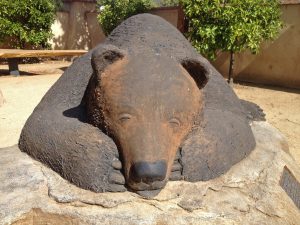
“The most important part of the whole thing is to stay an artist,” he says. “Most of the people I know who went to art school don’t do art anymore.”
Remaining an artist allows Shives to wake up in the morning knowing that he will spend the day doing what he wants to do, and being who he is. “Then I feel as good as I can feel.”
Shives is pleased about the upcoming exhibit in part because he hopes to inspire other would-be artists to follow their own paths, as he did.
“What you’re doing is inventing your life,” he says. “Anyone can do this if they really wanted to. You sit down and figure out how to do it. But most people are too smart for that. They go for the money.”
Not Dennis Shives. He chose freedom instead. He’s happy with the way things have worked out for him, and he thinks more people should make the same choice, so that they “can have a great life too.”
“I had a wonderful time,” he says. “I really did.”
